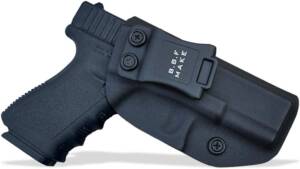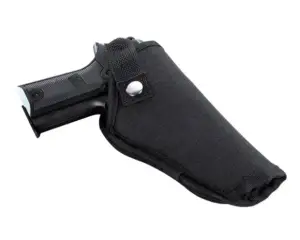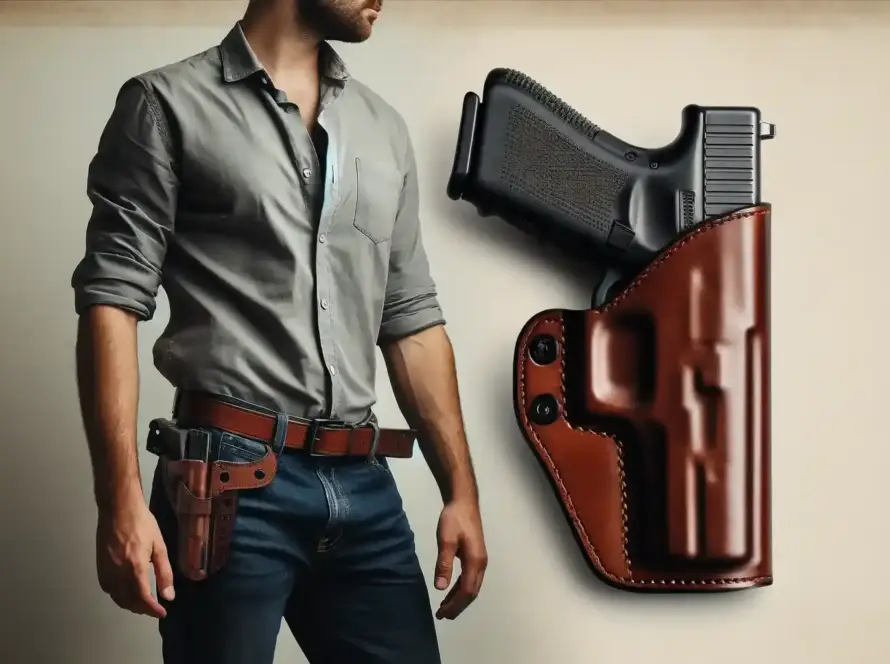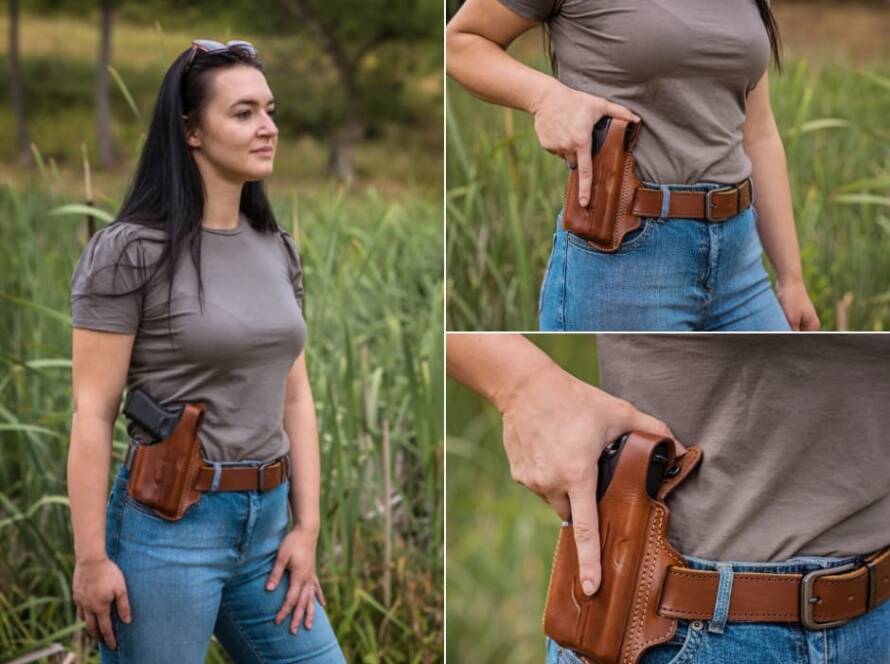In This Article-
- Introduction
- About Popular Material Types
- What to Pay Attention to When Choosing the Holster Material?
- Holster Materials and Their Retention Capacity
- Retention Methods
- Retention Levels
- Final Notes
There’s no such thing as the best holster material. The one that is considered the best by many, might not serve your specific needs. You need to figure out for yourself what you value the most, comfort, look, retention or any other feature. Once you are clear on these aspects, it will be a lot easier to finalize the holster material that tailor to your specific requirements. First, we will discuss basic and the most used materials for the holster and go on to define certain challenges that arise while using the holster for a firearm and how those challenges affect our decision of choosing the right holster material for our very own specific needs.
There are generally three basic types of holsters that are being produced and that are commonly preferred:
Leather holsters, the newer Kydex holsters, Nylon and then there are hybrid holsters.
All of these types of materials have their unique benefits as well as disadvantages. Let’s get to the depth of each material type-
Leather

Leather is a classic holster material that has an aesthetic appeal to it. Leather is durable and looks elegant. It has been a conventional holster material and it is still a popular choice of gun owners. Leather holsters are comfortable to wear and once they get broken in, leather holsters get adjusted to the specific body type. These can be designed to suit a particular firearm model as well as the accessories for the firearm you carry. Find a comprehensive guide here on selecting the right leather holster for women.
Upsides
- For a concealed carry weapon, Leather holsters are considered a good choice. Leather holsters are a great option specifically for IWB, OWB, Pocket, and Appendix carry.
- Considering the fact that leather holsters get adjusted to the body type over time, they offer great comfort. They are a great option in terms of strength and durability as well.
- Leather holsters are super quieter while drawing and re-holstering the firearm.
Downsides
- Leather requires high maintenance. If it isn’t maintained properly, leather can accumulate moisture which can lead to discomfort.
- With usage over a long period of time, it can get softer making reholstering tricky.
- You need to make sure of the quality of color and dyes on it because a bad quality dye can bleed color damaging your clothing items.
- Daily wear and tear and scratches can also affect the look of leather.
- Some people can find reholstering the firearm a bit difficult as compared to a Kydex holster.
Here’s a complete guide on Cleaning and Maintaining Your Leather Glock Holster
In leather holsters, stitching matters a lot. We need to make sure the edges are smoothed out. A feature of leather holsters is that the more you use it, the better the fit will be. The firearm will start to adhere to the holsters. www.youtube.com/@sootch00 suggests a good trick for it by making use of a Ziplock bag. We put the pistol in the Ziplock bag, insert it in the leather holster and leave it overnight as it is. This will smoothen the draw and re-holstering of the pistol in the holster.
Kydex

Kydex holsters are becoming more and more popular now. Thin and extremely lightweight size of Kydex holsters works in their favour making these a good option for a concealed carry weapon. Unlike Leather or synthetic, Kydex doesn’t collapse when the firearm is drawn. This feature is specifically useful in high-stress situations when re-holstering the firearm has to be quick and snag-free. Kydex holsters are also good for concealed carry.
Upsides
- Kydex holsters are easy to clean. This material doesn’t require high maintenance like Leather does. Kydex is resistant to water and dirt. Even if a Kydex holster is terribly soiled, it’s easy to clean it.
- Even when the firearm is drawn, Kydex maintains its shape which is highly necessary in high stress situations.
- Kydex holsters can be designed to fit a specific model firearm.
Downsides
- Kydex material does not adjust to the body over time as leather does. So, make sure you get the right fit to begin with.
- Although Kydex holsters are good for a concealed carry yet these do not offer as much comfort and snug fitting as leather and other synthetic material holsters do.
- They do make a noise while re-holstering the firearm.
Nylon

Nylon holsters are comfortable to wear and are more waterproof as compared to leather. Nylon holsters also provide a good protection to the firearm. These are usually bulky in size. So, these aren’t very good for a concealed carry weapon. It is also difficult to keep these clean as compared to Kydex holsters. Re-holstering is certainly not easy with Nylon holsters.
Upsides
- Nylon holsters are comfortable to carry because these are very lightweight.
- Feel good against your body while carrying inside the waistband.
- These are low-maintenance.
- Offer good firearm protection
Downsides
- Nylon holsters are not that durable.
- Reholstering is difficult because they tend to collapse.
- Nylon holsters are not a good option for a concealed carry
Many synthetic fabrics are being used to create low maintenance and sturdy holsters. These fabrics possess properties that place them between leather and Kydex holsters.
Hybrid

Opting for a hybrid holster that combines a Kydex shell with a leather backing can provide the best of both worlds. These holsters offer the comfort of leather while also benefiting from the durability and precision design of Kydex. Certain types of hybrid holsters feature reinforced leather to prevent the holster from collapsing after the firearm is drawn. Additionally, some holsters incorporate polymer between the leather layers to enhance sturdiness. Another variation includes a combination of leather backing and a Kydex sheath for the firearm. Some holsters combine a breathable neoprene backing with a sturdy Kydex sheath for the firearm.
Upsides
- Hybrid holsters offer better features for reholstering the firearm
- These are durable
- Provide precise design features for the firearm
- In terms of looks and usage, more options are available in hybrid holsters
Downsides
- Hybrid holsters are not cost-effective. Despite their advantages, these holsters are not as popular due to the availability of more cost-effective Kydex options.
- These are bulkier as compared to Kydex holsters.
What to Pay Attention to When Choosing the Holster Material?
Merely understanding the materials used in holsters is insufficient for selecting the ideal holster material. Various factors must be considered when using the holster with the firearm, such as comfort during extended wear, ease of drawing the firearm, and the risk of it falling out easily. Ultimately, the choice between these materials depends on personal preferences.
Comfort
Leather provides a padding and kind of cushioning effect which is easy on the skin. It is more comfortable and pliable when applied against the body and provides a quieter, stealthier draw than its counterpart. But other materials like neoprene offer breathable backing for the holster which make it easy for an everyday carry.
Reholstering
Kydex holsters remain in the exact same state whether or not the firearm is inside of it or not. Every other type of holster will partially collapse depending upon the material. Although for people who prefer comfort, reholstering easily is not the priority. And they would go for reinforced leather for the shell of the firearm. Reinforced leather does make reupholstering easier but not quite as well as Kydex does. It certainly is comfortable though.
Customization
Kydex holsters give more flexibility in terms of customization as well as adjustable retention. But if one finds leather to be more aesthetically appealing in terms of the look and prefers a sweat resistant material for the padding of the holster, then Hybrid holsters are a great choice for them.
Retention
This particular item may appear somewhat complex. When discussing holster retention, two terms that are frequently used are Passive and Active.
Passive Retention:
Passive Retention simply necessitates that the firearm remains in place due to the friction created by the inside lining of the holster. This friction can result from the material used, whether it be Nylon, Kydex, or Leather. Holsters with a Level I retention are typically closely fitting holsters without any active retention mechanisms to secure them.
Active Retention:
Active Retention involves the use of a retention device, such as a thumb break, hood, button, or trigger guard, that actively secures the firearm in the holster.
Holster Materials and Their Retention Capacity
Leather holsters possess a natural advantage due to the friction caused by the material, allowing them to securely hold the firearm. If the leather is left raw on the inside, without being smoothed or sanded down, it can grip onto the firearm and create friction. By crafting a molded leather holster that perfectly fits the firearm, an ideal passive retention holster is created.
On the other hand, Kydex does not possess the same natural ability to retain the firearm, as it is a smooth material that needs to be shaped. The security of Kydex holsters comes from the addition of a retention screw and/or an active retention mechanism.
Does the average person need a retention holster?
The need for a certain retention level is closely related to the kinds of settings in which we will be using the firearm. A good level 1 retention/ passive retention generally does the work. A Level II or especially a Level III (or higher) requires extensive training and practice for a quick draw and reholstering the firearm in a snag-free manner.
Typically, the higher levels of retention (Level III+) are necessary for Law Enforcement and Military and there is a good and valid reason for this. Military and Law Enforcement Officers are subject to rigorous and frequent training with their equipment. Further, they are much more likely to encounter a hostile situation in the course of duty and the holster must have enough retention capacity so as not to make it easy for someone else to take hold of the firearm.
Retention Methods
Once your firearm is in the holster, it is crucial to ensure that it remains securely in place until you intend to draw it. However, when the need arises, it should be easily accessible. To achieve this, there are several retention methods available. Various types of holsters utilize different levels of retention.
Friction
Certain holsters rely solely on the friction between the gun and the holster to hold it in place. This is commonly seen in concealed carry holsters. For everyday use, this method works effectively. Since your concealed weapon is not visible, there is minimal risk of someone attempting to grab it.
Additionally, if you are not engaging in vigorous activities, a well-made and properly fitted holster should securely hold your gun. Many modern holsters even feature a retention screw that allows you to adjust the level of friction and enhance the gun’s security.
Flaps
Traditional military holsters often incorporate a flap that covers the weapon’s butt, ensuring its security. These designs excel at preventing the gun from accidentally falling out and also provide protection against rain, dust, and mud. However, using flap holsters requires additional time as you need to open the flap before accessing your gun. While they are suitable for field use, they are not ideal for everyday civilian carry.
Straps
If you do not require extended protection for your pistol against the elements, a thumb break strap is a preferable alternative to a flap. The straps commonly found on traditional police and open carry holsters can be quickly released. Although they prevent the gun from falling out, they may not be as effective in preventing someone from grabbing it, as the strap can be easily released by others. Thumb loops, which typically go over the hammer, are similar to straps but lack a fastener.
Trigger Guard Locks
A more contemporary solution often found in rigid holsters, particularly those used by law enforcement, is the trigger guard lock. This mechanism provides enhanced security for the gun.
Retention Levels
Level of retention plays a very important role in determining the quality of the holster. Lower level of retention is good for a quick and snag-free draw but it makes it not so difficult/complicated for someone else to grab the gun. On the other hand, higher-level retention makes it difficult for others to take hold of the firearm from you but it can also slow down your own speed of drawing the firearm in situations that are time-sensitive.
Most importantly as long as a holster has a good retention, it’s alright if we use the same holster for different pistols that aren’t very distinct from one another in terms of dimensions. Every quality holster will have some kind of mechanism in place that enables us to change the tightness of the retention of the locking process and the way you can hold on to the pistol.
Let’s understand different retention levels that are cost commonly used in a variety of holsters-
Level 1
A majority of concealed carry holsters have Level 1 retention. Level 1 retention depends on friction (between the firearm and the inside lining of the holster) to hold the firearm in its place. A properly-fitted Level 1 holster is safe enough to hold the firearm in place during various movements and activities. But it offers no specific deterrent to anyone trying to grab the firearm from you.
Level 2
Along with the friction between the inside lining of the holster and the firearm, Level 2 offers an extra step in the form of a strap or in some cases, a trigger guard lock.
Level 3
Level 3 makes use of friction, a trigger guard, and a strap to add extra retention to the holster. Level 3 retention is generally preferred by the law enforcement departments.
Level 4
Level 4 offers a high level of security for the firearm. Along with the friction, a trigger guard, and a strap, Level 4 has an added retention mechanism which is different for different holsters. It could be an extra strap or another locking system. It is almost impossible for any other person to get hold of the gun without your own assistance in some way.
Sweat Guards
Sweat guards are really useful for the gun as well as the magazine. The slide as well as the grip of the firearm can create discomfort. In that case, you should use the raised sweat guard. It will help protect your skin while also protecting the gun from sweat which causes corrosion. So, when choosing the holster material, paying attention to the material of the sweat guard is very important too.
Final Notes:
Basically, a good holster is soft, pliable, and has a secure retention. And if you prefer a concealed carry, then the holster material should be such that it keeps you from printing. It should assist in making the draw smoother yet offer enough friction to retain the firearm from being grabbed by the others. It should be smooth on the firearm itself and have a snug fit as well. Way too rough texture of the inside lining of the holster can scratch the pistol. It would also be highly useful if the holsters already have a cut for the optics.



